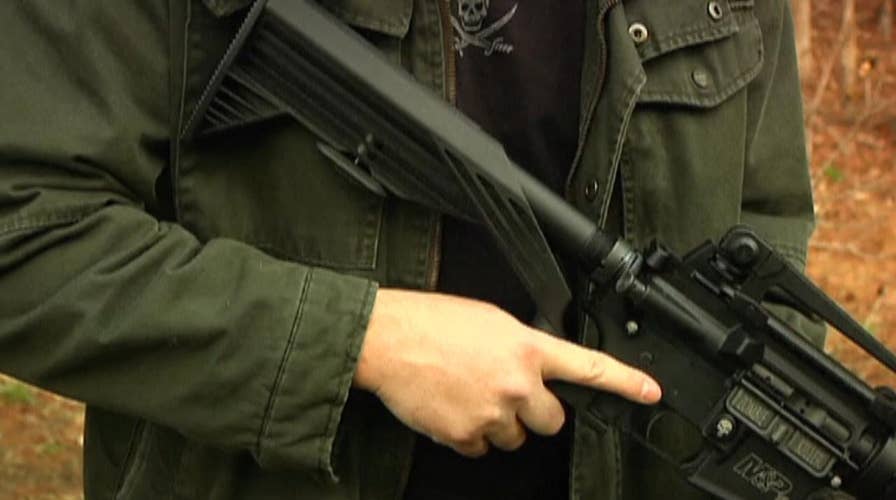Days after yet another mass shooting sparked a nationwide debate on gun control and an immediate response from lawmakers, President Trump took action.
The president signed an order on Feb. 20, 2018, directing the Justice Department to ban "bump stocks" and other gun modifiers that make semi-automatic firearms fire faster.
"We must move past clichés and tired debates and focus on evidence-based solutions and security measures that actually work," Trump previously said during a ceremony to honor the 17 victims of the shooting at Marjory Stoneman Douglas High School in Parkland, Florida.
BUMP-STOCK BAN HAS GUN-RIGHTS ADVOCATES UP IN ARMS
On Tuesday, a federal ban on bump stocks is set to go into effect — though gun rights groups are asking the Supreme Court to stop that from happening.
Here's what you need to know about bump stocks, the devices involved in the 2017 Las Vegas shooting.
How do they work?
A bump stock is an attachment that allows a semi-automatic rifle to mimic a fully automatic weapon's "cyclic firing rate to mimic nearly continuous automatic fire," according to the Bureau of Alcohol, Tobacco, Firearms and Explosives (ATF).
Semi-automatic rifles with bump stocks could fire hundreds of rounds per minute, according to experts.
They were originally created to make it easier for people with disabilities to fire a gun. The device essentially replaces the gun's stock and pistol grip and causes the weapon to buck back and forth, repeatedly "bumping" the trigger against the shooter's finger.
Are they legal?
Bump stocks had been legal under federal law. The ATF gave its seal of approval under the Obama administration in 2010. Since then, the government estimates more than 500,000 have been sold.
At the time, the bureau concluded bump stocks didn't convert a semi-automatic firearm into one that is fully automatic, meaning it was not equivalent to machine guns that are regulated under the National Firearms Act, which dates back to the 1930s.
However, it was illegal for U.S. citizens to own fully automatic firearms produced after May 19, 1986, The New York Times reported.
“The classification of these devices depends on whether they mechanically alter the function of the firearm to fire fully automatic,” Jill Snyder, a special agent in charge at the ATF, told The Times. “Bump-fire stocks, while simulating automatic fire, do not actually alter the firearm to fire automatically, making them legal under current federal law.”
But since the Las Vegas shooting, states and cities increasingly pushed for legislation to ban the devices.
Massachusetts became the first state to pass legislation banning the device after the incident. The state law, which went into effect Feb. 1, 2018, prohibits possession of the device under all circumstances. It also bans the possession of trigger cranks.
TRUMP ADMINISTRATION MOVES TO BAN SALE OF BUMP STOCKS, MAKE POSSESSION ILLEGAL BY MARCH
New Jersey, as well as large cities such as Denver and Columbia, South Carolina, also have enacted laws prohibiting the sale and possession of bump stocks. California law already prohibited the sale of bump stocks.
The National Rifle Association (NRA) even called for an immediate review of bump stocks after the Vegas shooting.
"The NRA believes that devices designed to allow semi-automatic rifles to function like fully-automatic rifles should be subject to additional regulations," the NRA said in a statement at the time.
Under this new federal ban, the government isn't allowing existing owners to keep their bump stocks. They must be destroyed or turned over to authorities. And the government isn't offering any compensation for the devices, which can cost hundreds of dollars. Violators can face up to 10 years in prison and thousands of dollars in fines.
What other actions has Trump taken?
Trump assured Americans that something would be done about bump stocks very quickly.
"I'm writing that out myself. I don't care if Congress does it or not," he said in February 2018. "You put it into the machine gun category, which is what it is, it becomes, essentially, a machine gun, and nobody is going to be able to — it's going to very hard to get them."
Last year, Trump signed a $1.3 trillion omnibus spending bill, which included several policy changes aimed at curbing gun violence, including the so-called "Fix NICS" measure to strengthen the background check system.
The measure to fix the National Instant Criminal Background Check System (NICS) provides additional funding to agencies and states that comply with the system. Those that do not, will be penalized.
More than $2 billion was also allocated to train school officials and law enforcement officers to identify signs of potential threats. This money would also be used to install metal detectors.
Another main action Trump has taken on guns has been to sign a resolution blocking an Obama-era background check rule designed to keep guns out of the hands of certain mentally disabled people.
Obama's rule, which affected an estimated 75,000 people, required the Social Security Administration to forward to the Justice Department the names of certain disabled beneficiaries to be added to an FBI database of individuals ineligible to purchase a firearm.
Fox News' Kaitlyn Schallhorn, Lucia I. Suarez Sang and The Associated Press contributed to this report.










































